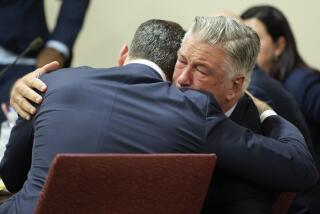AFTER THE RIOTS: THE SEARCH FOR ANSWERS : Jurors Tell of Angry, Bitter Deliberations : Trial: Heated debate centered on counts against Powell. ‘I felt he was guilty,’ a panel member says. ‘But I couldn’t prove it to myself.’
- Share via
It was Sunday, shortly before noon, the fourth agonizing day of deliberations in the case of four Los Angeles Police Department officers accused of beating Rodney G. King, and emotions were running high. The jurors were arguing heatedly over whether Officer Laurence M. Powell, who had been seen worldwide on a videotape striking a prone King, was guilty of assault with a deadly weapon.
When they finally cast their votes--a unanimous not guilty on that count--one male juror broke down and cried. As hard as he tried, he said, he could not persuade himself that the blows Powell inflicted were “likely to cause great bodily injury,” as the law required.
“I felt he was guilty,” he said. “But I couldn’t prove it to myself, so I had a real tough time, a real tough time putting in a not guilty vote.”
In an extensive interview with The Times, this juror--who asked not to be named--provided the most detailed account yet of what happened inside the small second-floor jury room in the Simi Valley courthouse. It was there that six men and six women met for seven days to pass judgment on Powell and fellow officers Timothy E. Wind and Theodore J. Briseno, and their sergeant, Stacey C. Koon.
His remarks, coupled with recent comments from the handful of jurors who have broken a pact not to talk, paint a portrait of a jury panel that at times fought bitterly over Powell, which resulted in the judge declaring a mistrial on one count, but had little trouble deciding to acquit the other three officers. A female juror, who also asked not to be identified, said: “Our biggest effort was put in on Powell. . . . It was very emotional.”
Most of the jurors have repeatedly declined interviews, many of them frightened by the riots that erupted in Los Angeles after their verdicts and fearing that publicity will bring them harm. Some, such as the male juror who asked not to be named, have moved out of their homes. Others have switched their telephones to unlisted numbers. One woman was so rattled by the threats she received that, a relative said, she is under a doctor’s care and has orders not to talk.
On Wednesday, the Simi Valley Police Department opened a criminal investigation into threats made to the jurors on the King panel, as well as threats against prospective jurors who were not selected and people whose names are similar to those of the jurors. Lt. Bob Klamser said police are working with the jurors to ensure their safety.
“It’s a scary situation,” said one male juror who declined to be identified and would not talk at length. “You need to keep a low profile.”
The jury panel--10 whites, a Latina and an Asian-American--began its work on Thursday, April 23. Like everything else in the spanking new East Valley Courthouse, the jury room had never before been used. It was bare, save for a table that sat 12, a television set that had been used during the trial to view the videotape, and the evidence--including the batons that Powell and Wind used against King. The blinds were drawn, and they remained that way throughout the jury’s discussions.
After selecting the forewoman--a 65-year-old Camarillo woman who manages government contracts for a living--the panel began by discussing the case against Briseno and Wind. According to the male juror, there was a consensus that those cases would be easier to resolve.
Briseno was charged with kicking King once. During his testimony, he argued that he tried to prevent the beating by pulling back Powell’s baton and by attempting to subdue King by putting his foot on King’s back--rather than kicking King, as the prosecution alleged. Watching the videotape in slow motion, the jury tried to determine where Briseno’s foot met King’s body. Was it on the head, as the prosecution asserted? On the neck? On the shoulder?
“It wasn’t really clear enough on the video to see,” the juror said. “So we were trying to rely on King’s movement after the kick, to try to determine where it was.”
He said the jury decided that there was a “reasonable explanation” for what Briseno did. And that meant reasonable doubt that he was guilty.
Of the four officers, Wind received the least attention from the jury. A rookie officer on probation who has been fired from the force, Wind was the only defendant not to testify in his own behalf. The jury believed Wind used “proper form,” the juror said, adding: “He only seemed to go in there and deliver blows when King was trying to rise. It looked like he was pretty much in control.”
Friday evening, the jury took straw votes on Briseno and Wind. The votes were cast by secret ballot. The decision was unanimous: not guilty for each officer. But in case anyone wanted to change his mind, the jury decided it would not take its final vote until deliberations were completed.
On Saturday morning, the jury embarked on its most difficult task: dissecting the evidence against Powell. The 29-year-old officer, a 3 1/2-year veteran of the Police Department, was accused of inflicting the most baton strikes on King. On portions of the videotape, he is shown delivering a torrent of blows to the King as King lay on the ground.
The panel began by considering the first count: assault with a deadly weapon, with force likely to produce great bodily injury. Much of the discussion revolved around whether King’s head injuries were sustained as a result of the baton strikes, as the prosecution alleged, or as a result of his fall to the ground, as the defense asserted.
Had King’s facial fractures been caused by the officers’ batons, the jury reasoned, they would have had proof that the force was likely to cause great bodily injury. But the jury accepted the defense argument instead.
After reviewing the tape repeatedly, the jurors could not tell whether Powell had struck King in the head--despite testimony from CHP officer Melanie Singer, who told the jury that she did see head blows. The juror said: “There are areas in the tape where you can’t see. It’s just too blurry and it jumps around a lot. I didn’t see any direct shots to the head.”
The debate continued all day Saturday and into Sunday, when the discussion grew volatile. One juror, said juror Virginia Loya, said that King deserved what he got. “That was a poor choice of words,” Loya retorted. “No one deserves to be beaten.” Others argued vociferously that the officers were reasonably in fear of King, a large man who they believed was under the influence of the dangerous drug PCP.
Near the end of the debate, Loya and another juror, both of whom had been arguing that Powell was guilty, changed their minds. The last holdout was the male juror, who said he cried as he cast his not guilty vote. With Powell acquitted of count one, the panel broke for lunch.
When they returned to the courthouse, the jurors were too drained to consider the second count against Powell: assault under color of authority. Instead they discussed count three--whether Powell had filed a false police report--and quickly determined that the errors on the report were “minor and insignificant.”
Then the jury moved to Koon, the sergeant who had twice stung King with his Taser stun gun. Although he did not inflict any blows against King, Koon, the supervising officer, faced the same charges as Powell, with the prosecution theorizing that if a crime had occurred, he was guilty of aiding and abetting. By the end of the day Sunday, the jurors agreed that unless they convicted Powell, they could not convict Koon.
On Monday, they returned to Powell to consider the second count. By then, the battle lines had been drawn. It was apparent that on this count, the jury would be hung. Nonetheless, the panel calmly embarked on a painstaking review of the videotape.
Those who favored conviction identified three key areas on the tape that, they believed, provided proof of excessive force. The most damaging portion, according to the male juror, showed Powell hitting King’s legs while King “appears to be rolling on the ground, just trying to avoid the blows.”
All day long, they reviewed these portions and went around the table, with each juror offering his views as to why Powell was or was not guilty. At the day’s end, the vote was 9 to 3 in favor of acquittal. At one point, Loya said, the other jurors lambasted her for insisting on playing the tape so many times.
“They were tired of watching,” she said. “To me, the video was the only thing I had to hang on to. I wanted to see it as much as I could.”
Loya said the debate over Powell was so wrenching that she prayed and fasted for a day and a half, hoping that God would give her the strength to persuade the others that the officer was guilty.
“I saw the swings,” she said Wednesday, referring to the baton blows Powell delivered to King. “He didn’t even take time to look at what he was doing. To me, it was out of control.”
The jury spent the next day, Tuesday, reviewing circumstantial evidence against Powell. Much of the discussion centered on his widely reported computer messages, including one issued after the beating in which he said: “Ooops, I haven’t beaten anyone that bad in a long time.” But at the end of the day, only one juror had switched his vote, and the jury was hung, 8 to 4.
On Wednesday, the final day of deliberations, “the sheriffs that were guarding us seemed edgier, and a lot more trying to keep us going on schedule,” the juror said. “We all felt a little pressure, like maybe we were expected to have already given them something.”
In fact, there was not much more to do. With no convictions against Powell, the jury--by this time “pretty emotionally wrung out,” one source said--could not find Koon guilty. With the final votes tallied, there were not guilty verdicts on 10 counts and a hung jury on the 11th. At 12:30 p.m., the forewoman sent a note to Superior Court Judge Stanley M. Weisberg.
The jury in the matter of People vs. Powell--as the case is officially known--had reached a partial verdict. The panel, the note said, would await the judge’s guidance.
Staff writers Tina Daunt and Stuart Silverstein contributed to this article.
More to Read
Sign up for Essential California
The most important California stories and recommendations in your inbox every morning.
You may occasionally receive promotional content from the Los Angeles Times.










